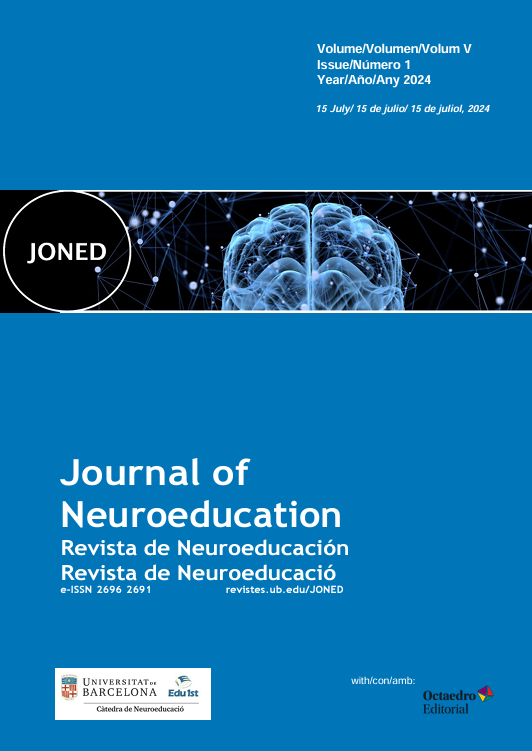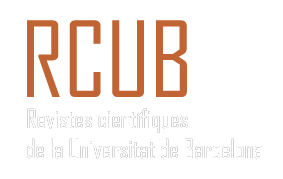Exploring Educational Neuroscience as a Professional Practice
DOI:
https://doi.org/10.1344/joned.v5i1.46064Keywords:
Educational Neuroscience, Profession, Career Opportunities, Mind, Brain, and Education, Job DescriptionAbstract
Educational neuroscience can be viewed through two lenses: as an academic discipline and as a professional practice. This review specifically focuses on the latter, arguing that a clear picture of the professional landscape of the field is as important as defining its disciplinary boundaries. In this context, the first part of this review examines whether educational neuroscience meets the criteria for professional specialisation. The analysis shows that educational neuroscience fulfills the standards of a professional specialty, with experts having the necessary training and skills to provide educational services to individuals, groups, or organ-izations. Consequently, they deserve legal authorization and formal recognition like their peers from other disciplines. However, in order to pave the way for professional recognition, educational neuroscientists must clearly outline career op-portunities within the field and ar ticulate the roles and skills each career requires. Accordingly, the second part of the paper is dedicated to identifying potential career opportunities for graduates in educational neuroscience. Currently, career opportunities for educational neuroscientists are often limited to academic roles in colleges and universities or involvement in research institutions. However, as the field develops, there’s potential for a wider range of new and exciting career opportunities, such as scientist-practitioners working with educators to design effective pedagogical interventions and educational science writers translating complex scientific findings into clear and accessible materials for the public. To help the field flourish as a profession, it is strongly recommended digital net works be created for educational neuroscience professionals from diverse backgrounds. These networks would provide opportunities for them to share experiences, exchange perspectives, and actively shape professional practice within the field.
Downloads
References
Siegel ST, Matthes E. Education’s relative autonomy: A closer look at the discipline’s past, present, and future. Nordic Studies in Education. 2022; 42:13-29. Available from: https://doi.org/10.23865/nse.v42.3785
Deng Z. Practice, pedagogy, and education as a discipline: Getting beyond close‐to‐practice research. British Educational Research Journal. 2023. Available from: https://doi.org/10.1002/berj.3951
McCulloch G. Disciplines contributing to education? Educational studies and the disciplines. British Journal of Educational Studies. 2002; 50:100-119. Available from: https://doi.org/10.1111/1467-8527.t01-1-00193
Nouri A. The basic principles of research in neuroeducation studies. International Journal of Cognitive Research in Science, Engineering and Education (IJCRSEE). 2016; 4:59-66. Available from: https://doi.org/10.5937/IJCRSEE1601059N
Summak MS, Summak AEG, Summak PŞ. Building the connection between mind, brain, and educational practice; roadblocks and some prospects. Procedia-Social and Behavioral Sciences. 2010;2:1644-1647. Available from: https://doi.org/10.1016/j.sbspro.2010.03.251
Ferrari M, McBride H. Mind, Brain, and Education: The birth of a new science. Learning Landscapes. 2011;5:85-100. Available from: https://doi.org/10.36510/learnland.v5i1.533
Nouri A, Tokuhama-Espinosa TN, Borja C. Crossing Mind, Brain, and Education Boundaries. Cambridge Scholars Publishing; 2022. Available from: https://www.cambridgescholars.com/product/978-1-5275-9075-5
Thomas MSC, Ansari D. Educational neuroscience: Why is neuroscience relevant to education? In: Thomas MSC, Mareschal D, Dumontheil I, editors. Educational neuroscience: Development across the life span. Routledge/Taylor & Francis Group; 2020. p. 3–22. Available from: https://doi.org/10.4324/9781003016830-2
Fischer KW, Goswami U, Geake J, Task Force on the Future of Educational Neuroscience. The future of educational neuroscience. Mind, Brain, and Education. 2010; 4:68-80. Available from: https://doi.org/10.1111/j.1751-228X.2010.01086.x
Wilson D, Conyers M. Five big ideas for effective teaching: Connecting mind, brain, and education research to classroom practice. New York, N.Y.: Teachers College Press; 2020. Available from: https://doi.org/10.1111/teth.12196
Bruer JT. Where is educational neuroscience? Educational Neuroscience. 2016; 1:1-12. Available from: https://doi.org/10.1177/2377616115618036
Dubinsky JM, Guzey SS, Schwartz MS, Roehrig G, MacNabb C, Schmied A, et al. Contributions of neuroscience knowledge to teachers and their practice. The Neuroscientist. 2019;25:394-407. Available from: https://doi.org/10.1177/1073858419835447
Jolles J, Jolles DD. On Neuroeducation: Why and How to Improve Neuroscientific Literacy in Educational Professionals. Frontiers in Psychology. 2021; 12:752151. Available from: https://doi.org/10.3389/fpsyg.2021.752151
Pincham HL, Matejko AA, Obersteiner A, Killikelly C, Abrahao KP, Benavides-Varela S, et al. Forging a new path for Educational Neuroscience: An international young-researcher perspective on combining neuroscience and educational practices. Trends in Neuroscience and Education. 2014; 3:28-31. Available from: https://doi.org/10.1016/j.tine.2014.02.002
Thomas MS, Ansari D, Knowland VC. Annual research review: Educational neuroscience: Progress and prospects. Journal of Child Psychology and Psychiatry. 2019; 60:477-492. Available from: https://doi.org/10.1111/jcpp.12973
Gardner H. Quandaries for Neuroeducators. Mind, Brain, and Education. 2008; 2:165-169. Available from: https://doi.org/10.1111/j.1751-228X.2008.00050.x
Schwartz MS, Paré-Blagoev EJ, editors. Research in Mind, Brain, and Education. Routledge; 2017. Available from: https://doi.org/10.4324/9781315670621a
Zhao Q. On the role of teachers’ professional identity and well-being in their professional development. Frontiers in Psychology. 2022; 13:913708. Available from: https://doi.org/10.3389/fpsyg.2022.913708
Fuller JK, Glendening JG. The neuroeducator: Professional of the future. Theory into Practice. 1985; 24:135–137. Available from: https://doi.org/10.1080/00405848509543161
Schwartz M. Mind, brain, and education: A decade of evolution. Mind, Brain, and Education. 2015; 9:64–71. Available from: https://doi.org/10.1111/mbe.12074
Tapper A, Millett S. Revisiting the concept of a profession. In: Conscience, leadership and the problem of ‘dirty hands’. Emerald Group Publishing; 2015. p. 1–18. Available from: https://doi.org/10.1108/S1529-209620150000013001
Feiler JB, Stabio ME. Three pillars of educational neuroscience from three decades of literature. Trends in neuroscience and education. 2018; 13:17-25. Available from: https://doi.org/10.1016/j.tine.2018.11.001
Tokuhama-Espinosa T, Nouri A, Daniel D. Evaluating what Mind, Brain, and Education has taught us about teaching and learning: 2020 International Survey. 2020. Available from: https://doi.org/10.46786/ac20.1386
Hobbies MH, et al. “UNIFIED”: bridging the researcher–practitioner divide in mind, brain, and education. Mind, Brain, and Education. 2019; 13:298-312. Available from: https://doi.org/10.1111/mbe.12223
Chang Z, Schwartz MS, Hinesley V, Dubinsky JM. Neuroscience concepts changed teachers’ views of pedagogy and students. Frontiers in Psychology. 2021; 12:685856. Available from: https://doi.org/10.3389/fpsyg.2021.685856
Paré-Blagoev EJ, Booth JL. Examples at the boundaries: Using a research-practice partnership to improve teaching tools in algebra. In: Schwartz M, Paré-Blagoev EJ, editors. Research in Mind, Brain, and Education. New York, NY: Routledge; 2017. p. 208-233. Available from: https://doi.org/10.4324/9781315670621a
Amiel JJ, Tan YSM. Using collaborative action research to resolve practical and philosophical challenges in educational neuroscience. Trends in neuroscience and education. 2019; 16:100116. Available from: https://doi.org/10.1016/j.tine.2019.100116
Coch D. Reflections on neuroscience in teacher education. Peabody Journal of Education. 2018; 93:309-319. Available from: https://doi.org/10.1080/0161956X.2018.1449925
Zadina JN. The emerging role of educational neuroscience in education reform. Psicología Educativa. 2015; 21:71-77. Available from: https://doi.org/10.1016/j.pse.2015.08.005
Leisman G. Neuroscience in Education: A bridge too far or one that has yet to be built: Introduction to the “Brain Goes to School”. Brain Sciences. 2023; 13:40. Available from: https://doi.org/10.3390/brainsci13010040
Forsler I, Guyard C. Screens, teens and their brains. Discourses about digital media, learning, and cognitive development in popular science neuroeducation. Learning, Media, and Technology. 2023; 1-14. Available from: https://doi.org/10.1080/17439884.2023.2230893
Nouri A, Mehrmohammadi M. Defining the boundaries for Neuroeducation as a field of study. Educational Research Journal. 2012; 27:1-25. Available from: https://search.informit.org/doi/10.3316/informit.720595453017583
Nouri A. Practical strategies for enhancing interdisciplinary collaboration in neuroeducational studies. International Journal of Cognitive Research in science, engineering, and education (IJCRSEE). 2013; 1:94-100. Available from: https://www.ijcrsee.com/index.php/ijcrsee/article/view/8
Downloads
Published
Issue
Section
License
Copyright (c) 2024 Ali Nouri

This work is licensed under a Creative Commons Attribution-NonCommercial 4.0 International License.
The authors who publish in this journal agree to the following terms:
a. Authors retain copyright and grant the journal the right of first publication
b. Texts will be published under a Creative Commons Attribution Non Commercial License that allows others to share the work, provided they include an acknowledgement of the work’s authorship, its initial publication in this journal and the terms of the license, and not for commercial use.



